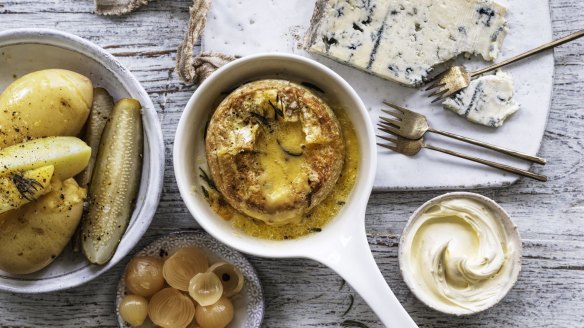Why does camembert smell like mushrooms?

Why does camembert smell like mushrooms? L. Kumar
A good cheese is a living thing, a slab of milk concentrated and transformed by enzymes, bacteria and fungus. The white fluffy exterior you see on a good camembert could be caused by a number of moulds that have been deliberately introduced by the cheesemaker. One is Penicillium camemberti. It is sprayed onto the cheese's exterior, where it settles and grows fine filaments that look like fine white velvet. The mould also produces enzymes that break down the fat from the milk. One of the compounds formed when the fat breaks down is called octen-3-ol. It is also called mushroom alcohol and gives off that mushroomy smell. It is really interesting to note that salume makers also use P. camemberti in the production of their small goods. If you see a salami or saucisson sec with a white bloom on the skin, it is most likely to be P. camemberti, and if you give it a sniff, it should have a pleasing fungal aroma. It is harmless and adding another layer of flavour to your fermented and air-dried sausage.
What is that flavour in Sausage McMuffins? P. Varney
I contacted the media department at McDonald's head office, but as yet, I have not received a reply. So, just for you, I ventured into a McDonald's early one morning to order one of these breakfast menu items. For readers who have never had a Sausage McMuffin, it is a beef patty with processed cheese served in a toasted English muffin. Inside the store I could not make out a lot of the flavours over the aroma of hot grease and tradies' Lynx. Outside, I gave the McMuffin a good sniff and a bit of a chew and found it had a really pleasing blend of high top notes that I assumed was mace (made from nutmeg casing). A later trawl through the McDonald's website revealed a pork patty seasoned with rosemary. But that was on the McDonald's US and British site. It is interesting to note that the Australian McMuffin has been reformulated and made with beef seasoned with pepper, chilli, rosemary, bay, nutmeg and coriander. These are classic spices used in the great European sausages that came to Australia with the post WWII migrants. A German master butcher I know uses a lot of nutmeg, and the more delicate spice called mace, and finely ground coriander seed in his bratwurst. These are bright, sharp top-end spices that the food technicians at McDonald's have balanced with the bass note of bay to give a deeper flavour to their beef patty. What I find interesting is that with the exception of chilli, Macca's style of sausage spice blend has been used in meat dishes since the Middle Ages.
Letters
Coming up to Easter, we have had a few emails about hot cross bun-induced power outages. "Purely for expediency in the mornings, I toast my bisected hot cross bun in the toaster," writes reader F. Parker. "Occasionally, this has tripped the main circuit breaker. On investigation, it appears that a stray raisin can create a stray current. Pardon the pun." On accoutrements for cheese, M. Artis writes, "Growing up in Denmark in the years after WWII, I learned early and happily that cheese needs crisp, sharp radishes freshly pulled from the garden and with a bit of coarse sea salt to dip them into. I don't have a sweet tooth, but I can tolerate a few black grapes. Having said that, I have memories of my mother topping her buttered French bread with cheese and crowning all with a decadent layer of marmalade."
Send your vexing culinary conundrums to brainfood@richardcornish.com.au or tweet to @foodcornish
Appears in these collections
- More:
- Food
- Brain food
